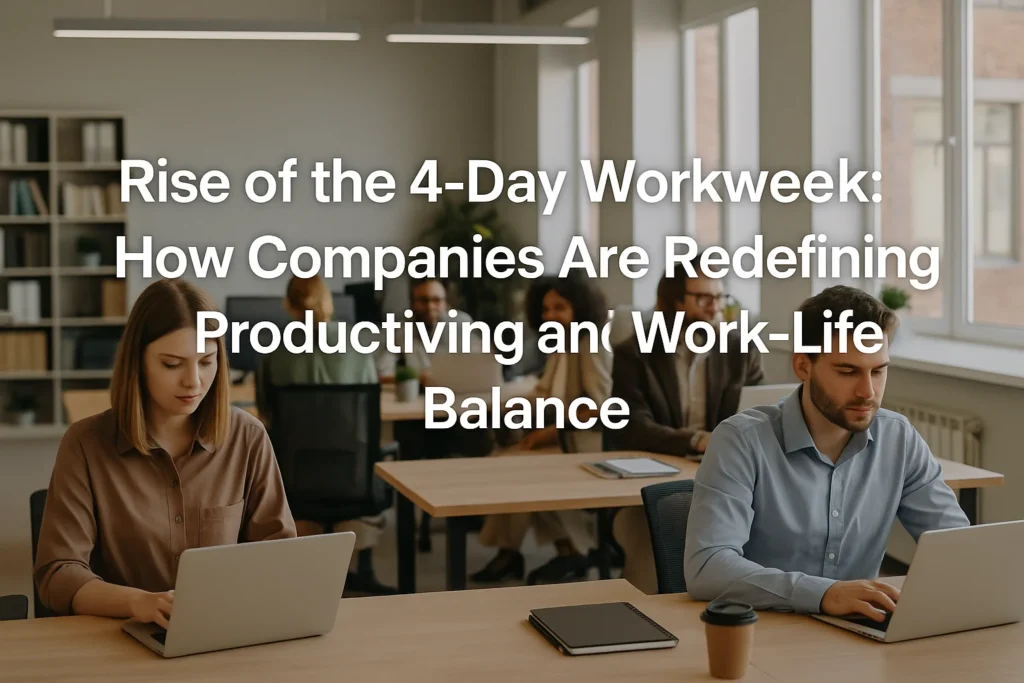Introduction: The Dawn of a Shorter Workweek
For decades, the standard five-day, 40-hour workweek has been the backbone of global economies, a routine ingrained in our lives. But what if there was a better way? What if working less could actually lead to more? In 2025, this idea is no longer a whispered hope in breakrooms; it’s a bold reality taking root in boardrooms and government offices worldwide. With growing evidence that shorter workweeks dramatically improve mental health, boost efficiency, and help companies hold onto their best people, the 4-day workweek is rapidly moving from a daring experiment to a permanent fixture for many.
From bustling tech hubs in the U.S. to serene villages in New Zealand and vibrant cities in Japan, companies are leading the charge. Even governments are starting to consider making it easier for businesses to adopt this model. This isn’t just about getting an extra day off; it’s about a fundamental rethinking of what “productivity” truly means and how we can achieve a healthier work-life balance in our increasingly demanding world. But how exactly does it work, what challenges arise, and what does this shift mean for the future of how we work and live?
Global Experiments: The Proof is in the Pilot
The idea of a shorter workweek isn’t entirely new, but recent, large-scale pilot programs across the globe have provided compelling evidence that it’s not just a pipe dream. These trials have shown that reducing workdays doesn’t necessarily mean reducing output. In many cases, it’s quite the opposite.
A New Rhythm of Work
- The UK’s Big Leap: One of the most talked-about trials took place in the United Kingdom, involving over 60 companies and nearly 3,000 employees. For six months, workers received 100% of their pay for 80% of their usual hours, aiming to maintain 100% productivity. The results were astounding: 92% of the companies chose to continue with the 4-day week, with 18 making it permanent. Employees reported significantly reduced stress (39% less) and burnout (71% less), while company revenues actually saw a slight increase. Absenteeism also dropped by a remarkable 65%, and staff turnover decreased by 57%. This showed that across various industries, from tech to small retail, the model could thrive.
- Japan’s Productivity Surge: In a country often known for its long working hours, Microsoft Japan’s trial was groundbreaking. They reported a nearly 40% boost in productivity during their 4-day workweek experiment. This demonstrated that focused work in shorter bursts could lead to higher quality output. Tokyo’s government is even set to introduce a 4-day workweek for its employees starting April 2025, partly to address declining birth rates and combat “karoshi” (death by overwork), recognizing the profound societal benefits.
- Iceland’s Public Sector Success: Between 2015 and 2019, Iceland ran large-scale trials in its public sector, with over 2,500 workers shifting to shorter weeks (from 40 to 35-36 hours) without a pay cut. The outcome? Improved well-being, reduced stress, and no loss in productivity. By 2022, over half of Iceland’s workforce had either moved to shorter hours or gained the right to do so.
- Germany’s Efficient Shift: Known for its efficiency, Germany’s 2023-2024 pilot with 41 organizations saw 73% express interest in continuing the model permanently. Even in a country with already relatively short average workweeks (around 34 hours), the benefits of an extra day off for focus and rejuvenation were evident.
These global pilots are not just isolated success stories; they form a growing body of evidence that a well-implemented 4-day workweek can be a win-win for both businesses and their employees.
A Healthier Workforce: The Promise of Well-being
One of the most compelling arguments for the 4-day workweek lies in its profound positive impact on employee well-being. It’s not just about more time off; it’s about creating a workplace that actively reduces burnout, increases engagement, and fosters a truly balanced life.
Beyond the Weekend
Imagine waking up on Friday morning knowing you have a full three-day weekend ahead. That extra day isn’t just for sleeping in; it’s a flexible space for life. For many, it means:
- Reduced Burnout and Stress: The most frequently cited benefit is a significant decrease in stress levels and professional burnout. Employees feel more rested and less rushed, leading to better mental health. Studies from various pilot programs show substantial reductions in anxiety, fatigue, and sleep issues.
- Increased Engagement and Motivation: When employees feel valued and have more control over their personal time, their morale and job satisfaction soar. They come to work on Monday feeling refreshed, more focused, and highly motivated to make the most of their four days. This heightened engagement directly translates to higher quality work and a more positive workplace culture.
- Better Work-Life Balance: This is perhaps the most obvious, yet most powerful, benefit. The extra day off allows people to truly disconnect and dedicate time to personal pursuits, family commitments, hobbies, or simply managing household chores that often eat into a traditional weekend. For working parents, it can mean eliminating an extra day of childcare. This improved balance leads to a more fulfilling life outside of work, which in turn feeds back into a more productive and happy employee.
- Improved Physical Health: With more time for exercise, proper meals, and sufficient rest, employees often report improvements in their physical health. This can lead to fewer sick days and a healthier overall workforce.
These well-being benefits are a powerful magnet for attracting and retaining top talent, especially as newer generations prioritize a holistic approach to life and work.
Navigating the Hurdles: Challenges and Adaptations
While the benefits of a 4-day workweek are clear, it’s not a one-size-fits-all solution. Implementing this model, especially in certain sectors, comes with significant challenges that require careful planning and innovative adaptations.
When Four Days Don’t Easily Fit
- Customer Service Concerns: Industries that rely on continuous customer interaction often face the biggest hurdles. If a company’s customer service lines or retail stores are only open four days a week, it can frustrate customers and lead to lost business. Solutions often involve staggered shifts, where different teams take different days off, ensuring constant coverage. This means not everyone gets the same “Friday off” but still benefits from a compressed week.
- Healthcare and Emergency Services: Imagine a hospital or fire station trying to operate on a 4-day workweek for all staff. These essential services require round-the-clock availability. Here, the 4-day week might look like compressed 10-hour shifts or creative scheduling that ensures full staffing while still giving individual employees more consecutive days off. The focus shifts from a universal ‘Friday off’ to increased personal flexibility.
- Manufacturing and Production: Factories often run on continuous production lines. Shutting down for a day or reducing hours without impact can be difficult. Companies in this sector might explore strategies like automation (more on this later) or shifting to longer daily shifts (e.g., four 10-hour days) to maintain output within fewer workdays, although this can raise concerns about employee fatigue.
- Global Operations: For multinational companies, coordinating a 4-day workweek across different time zones and cultures can be complex. What’s a long weekend in one country might be a crucial workday in another. Solutions often involve dedicated regional teams and robust digital communication tools.
- Internal Coordination: Even within an office environment, if half the team is off on Fridays and the other half on Mondays, scheduling meetings and ensuring seamless collaboration can be tricky. Companies need clear communication protocols and a strong culture of planning ahead.
- “Compressed Hours” vs. “Reduced Hours”: A key challenge is whether the 4-day week means compressing 40 hours into four longer days (e.g., 4×10 hours) or genuinely reducing hours to 32 while maintaining full pay. While both offer more days off, the latter typically provides greater well-being benefits, as it reduces overall workload pressure. The choice depends on the industry and company goals.
Overcoming these challenges requires open communication, flexible thinking, and a willingness to redesign workflows and operational processes. It’s not just about cutting a day; it’s about working smarter.
The Advocacy for Change: Unions, HR, and Tech Lead the Charge
The widespread adoption of the 4-day workweek isn’t happening by accident. It’s the result of powerful advocacy from various corners: labor unions, forward-thinking HR platforms, and innovative tech companies are all pushing for this systemic change.
A Unified Push for a Better Way to Work
- Labor Unions: A Historical Voice for Workers: Historically, labor unions have been at the forefront of advocating for reduced working hours, from the fight for the 8-hour workday to the 5-day week. Today, they see the 4-day workweek as the next logical step in improving workers’ lives and ensuring that the benefits of technological progress are shared widely. In countries like Iceland and Belgium, unions have played a crucial role in negotiating shorter workweeks or gaining legislative support for them. They argue that a healthier, happier workforce is a more productive and stable workforce, and that workers deserve to benefit from increased efficiency.
- HR Platforms: Enabling the Shift: HR technology companies are becoming crucial enablers of the 4-day workweek. They develop platforms that help businesses manage complex schedules, track productivity based on output rather than hours, facilitate seamless internal communication, and provide data on employee well-being. These tools are vital for companies looking to transition smoothly, offering solutions for time tracking, performance management, and ensuring fair implementation across teams. They help HR departments measure the impact and prove the return on investment of a compressed workweek.
- Tech Companies: Leading by Example: Many tech companies, often at the cutting edge of workplace innovation, have been early adopters and strong advocates. Their focus on results-driven work, combined with a culture of innovation and employee empowerment, makes them ideal candidates for experimenting with flexible models. Companies like Microsoft Japan have demonstrated that efficiency can soar with fewer hours, largely thanks to the very tools they develop. Their success stories provide powerful case studies that other industries can learn from.
- Global Advocacy Groups: Organizations like 4 Day Week Global have been instrumental in popularizing the concept, running pilots, collecting data, and sharing best practices worldwide. They provide blueprints for implementation, proving that the model is viable across diverse sectors and company sizes. Their comprehensive reports and ongoing campaigns put pressure on both businesses and governments to consider the shift.
This combined advocacy from different stakeholders creates a powerful momentum, turning what was once a fringe idea into a mainstream movement reshaping the global workforce.
The AI Advantage: Enabling More Output in Less Time
One of the quiet drivers behind the feasibility of the 4-day workweek is the rapid advancement of AI and automation. These powerful technologies are not just transforming industries; they are fundamentally changing how work gets done, enabling higher output with fewer human hours.
Working Smarter, Not Just Harder
- Automating Repetitive Tasks: Imagine spending less time on tedious, repetitive work like data entry, scheduling, report generation, or sifting through emails. AI-powered tools can handle these “mindless tasks” with incredible speed and accuracy. This frees up human employees to focus on more creative, strategic, and high-value work that truly requires human intelligence, problem-solving, and empathy. For example, AI can analyze market trends, draft initial reports, or even manage customer inquiries with chatbots, leaving employees to tackle complex client issues or develop new strategies.
- Boosting Productivity: Studies consistently show that AI tools can significantly boost individual and team productivity. Research from MIT and Stanford, for instance, suggests AI can improve worker output by an average of 14%, while Goldman Sachs estimates AI could automate up to 25% of job tasks globally. When a team can accomplish the same amount of work in less time, the transition to a 4-day workweek becomes not just possible, but logical, without sacrificing business goals.
- Enhanced Decision-Making and Insights: AI can quickly process vast amounts of data to provide insights that would take humans weeks or months to uncover. This helps employees make faster, more informed decisions, streamline workflows, and identify areas for improvement, further contributing to overall efficiency.
- Optimizing Workflows: AI can analyze work patterns, identify bottlenecks, and suggest more efficient ways of organizing tasks and collaborating. This optimization ensures that the compressed workweek doesn’t lead to rushed or lower-quality work, but rather to a more streamlined and purposeful approach.
The integration of AI and automation isn’t about replacing human workers for the sake of it; it’s about enhancing human capabilities and enabling a more efficient, focused, and ultimately, shorter workweek. As AI becomes more sophisticated, its role in unlocking future productivity gains for a 4-day model will only grow.
The New Workforce: Gen Z, Millennials, and Flexible Expectations
The landscape of work is also being reshaped by the evolving values and shifting expectations of Gen Z and Millennials. These generations, now forming the majority of the workforce, are not just seeking a paycheck; they are looking for flexible, value-driven workplaces that prioritize well-being and a purpose beyond profit.
Beyond the Traditional Ladder
- Prioritizing Work-Life Balance: Unlike previous generations who might have focused solely on climbing the corporate ladder, Gen Z and Millennials place a high premium on work-life balance. They witnessed the blurring lines between work and home during the pandemic, and many are unwilling to return to rigid 9-to-5 schedules that leave little room for personal life, family, or self-care. The 4-day workweek perfectly aligns with this desire for more personal time and flexibility.
- Value-Driven Employment: Younger generations are increasingly seeking employers whose values align with their own. Companies that demonstrate a commitment to employee well-being, sustainability, and innovative work models are far more attractive. Offering a 4-day workweek signals a progressive, employee-centric culture that resonates deeply with these values.
- Demand for Flexibility: The pandemic normalized remote work and flexible hours, proving that productivity isn’t tied to a physical office or a fixed schedule. Gen Z, in particular, grew up with technology that enables seamless connectivity anywhere, anytime. They expect flexibility in when, where, and how they work, and the 4-day week is seen as a natural extension of this flexibility.
- Attraction and Retention Magnet: For companies looking to attract and retain top talent, especially in competitive industries, offering a 4-day workweek has become a powerful differentiator. It’s often cited as a more significant perk than a pay raise for many candidates. Businesses that adopt this model report a surge in job applications and a significant decrease in employee turnover, creating a more stable and engaged workforce.
The expectations of Gen Z and Millennials are not just trends; they are fundamental shifts in what a fulfilling work life looks like. Companies that embrace models like the 4-day workweek are not just being progressive; they are strategically positioning themselves to attract and retain the best talent for the future.
Conclusion: A New Era of Work
In 2025, the rise of the 4-day workweek is undeniably here, reshaping how companies define productivity and work-life balance. Driven by compelling results from global pilot programs in the UK, Japan, and New Zealand, evidence overwhelmingly points to its success in maintaining or even improving output, while dramatically enhancing employee well-being through reduced burnout, increased engagement, and a better overall balance.
While challenges persist, particularly in sectors like customer service, healthcare, and global operations which require thoughtful adaptation, the momentum for this shift is undeniable. Labor unions, HR platforms, and tech companies are advocating for systemic change, proving that a shorter workweek isn’t just a perk, but a strategic move. Moreover, the powerful advancements in AI and automation are enabling higher output with fewer human hours, making the 4-day model increasingly feasible. This aligns perfectly with the shifting expectations of Gen Z and Millennials who demand flexible, value-driven workplaces.
As governments worldwide consider legislative support, the 4-day workweek isn’t merely an HR trend; it’s a fundamental reimagining of work, driven by a collective desire for a more human-centric, sustainable, and productive future. It signals a new era where efficiency is measured not by hours logged, but by the quality of output and the well-being of the people creating it.



